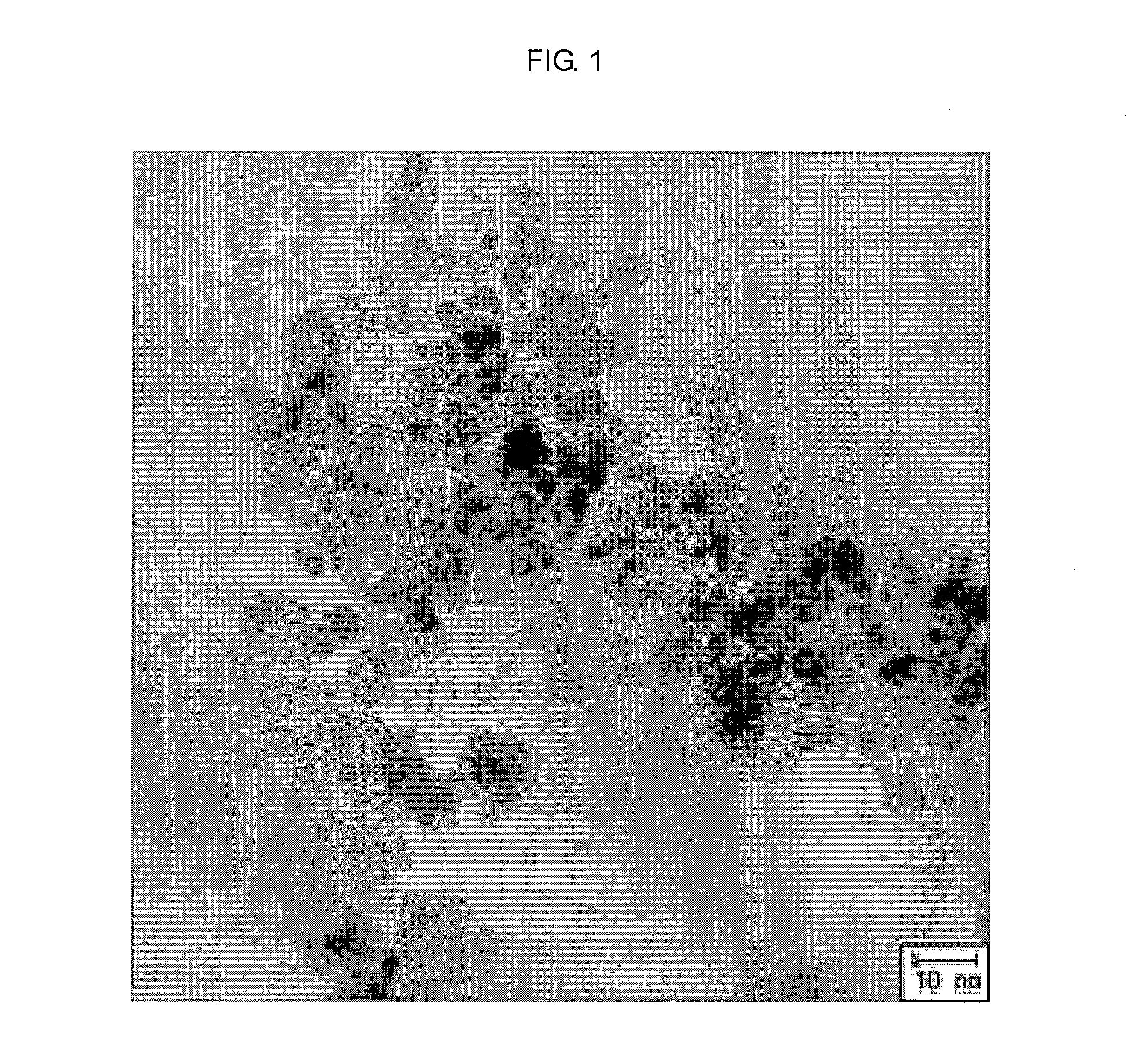Recyclable superparamagnetic nanoparticles and method for producing the same
a superparamagnetic nanoparticle, recyclable technology, applied in the direction of magneto-ferric oxides, iron organic compounds, ferroso-ferric oxides, etc., can solve the problems of high energy consumption, large energy consumption, and primary problems of forward osmosis membrane filtration, etc., to achieve high energy consumption, small hydrodynamic size, and practical
- Summary
- Abstract
- Description
- Claims
- Application Information
AI Technical Summary
Benefits of technology
Problems solved by technology
Method used
Image
Examples
example 1
Production of Superparamaqnetic Iron Oxide Nanoparticles Having Size Less than 20 nm in Water and Monodispersed Distribution>
[0037]9.54 g of FeCl2.4H2O, 25.9 g of FeCl3.6H2O and 7.2 g of sodium citrate were added and dissolved into 75 mL of distilled water in a sequential manner, thereby preparing a solution (Solution 1). Meanwhile, a mechanical stirrer was installed on a three-prong flask with a capacity of 2 L, and 750 mL of 1 M NaOH solution was prepared (Solution 2). While stirring the solution 2, the solution 1 was slowly added into the solution 2. After stirring the mixture for 5 hours more, iron oxide nanoparticles having a size of about 7 nm were produced. After reaction completed, the solution was centrifuged to obtain the nanoparticles. The obtained nanoparticles were washed using ethanol more than two times, and then dispersed in 250 mL of ethanol. From 10 mL of this solution were collected solids by use of a magnet. The collected solids were completely dried. A weight of...
example 2
Seawater Desalination Experiment
[0039]A seawater desalination experiment using forward osmosis was carried out by using 0.0065 M nanoparticle solution, which was prepared in Example 1, as a draw solution. 3.5% salt water was prepared to be used as seawater. A celluloid triacetate (CTA) membrane produced by Hydration Technology Innovations (HTI) was used as a membrane. Water flux when using the nanoparticles according to the present disclosure was measured, under conditions that the draw solution and a capacity of reservoir were 500 mL, respectively, a flow rate was 8.5 m / sec, and 10-hour operation was performed. The measurement result was 8 LMH, which was an excellent performance. It was confirmed that the superparamagnetic nanoparticles were easily recoverable from the draw solution using a magnet after operation, and recyclable by virtue of re-dispersibility thereof.
example 3
Dispersibility in Salt Water of Superparamagnetic Iron Oxide Nanoparticles Having Size of 7.06 nm in Water and Monodispersed Distribution
[0040]To estimate dispersibility of the nanoparticles under rigorous conditions using the nanoparticles produced in Example 1, the following experiment was carried out. Salt water with the same saline concentration (3.5%) as seawater was prepared. The nanoparticles produced in Example 1 were added to the salt water such that the concentration became 0.0065 M. This solution was stirred for 1 hour, and the nanoparticles were recovered by use of a magnet, followed by two-time washing, and then dispersed in water. Hydrodynamic diameters of the nanoparticles dispersed in water were analyzed, and the results were 8.1±1.2 nm. Accordingly, it was confirmed that no aggregation was caused before and after use of the nanoparticles. The results are shown in FIG. 5.
PUM
| Property | Measurement | Unit |
|---|---|---|
| size | aaaaa | aaaaa |
| temperature | aaaaa | aaaaa |
| size | aaaaa | aaaaa |
Abstract
Description
Claims
Application Information
 Login to View More
Login to View More - R&D
- Intellectual Property
- Life Sciences
- Materials
- Tech Scout
- Unparalleled Data Quality
- Higher Quality Content
- 60% Fewer Hallucinations
Browse by: Latest US Patents, China's latest patents, Technical Efficacy Thesaurus, Application Domain, Technology Topic, Popular Technical Reports.
© 2025 PatSnap. All rights reserved.Legal|Privacy policy|Modern Slavery Act Transparency Statement|Sitemap|About US| Contact US: help@patsnap.com



